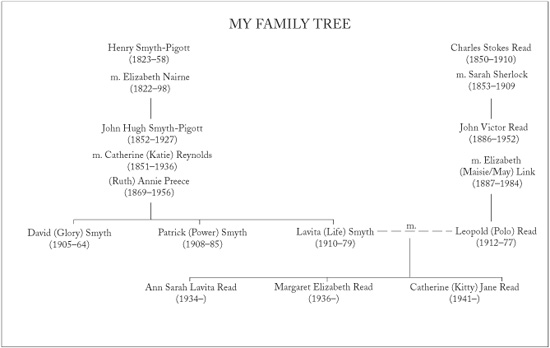
It seemed fitting that it was twilight that early summer evening in 2005 when I last strolled through the grounds of my childhood home. I was joined by Pam, the school friend who, all those years before, had been caught with me sliding on cushions in Eden. The forbidding entrance gates are no more. We strolled in past the darkening silhouette of the mansion, now divided into three sizable houses. When we rounded the corner of the building, Pam stopped in surprise. What used to be acres of lawn leading up to the path, where we would ride our ponies, our bicycles and play catch, were no more. Instead there are bungalows set in neat postage-stamp gardens; even the stables have been converted into a house.
‘Good heavens!’ she exclaimed.
‘I know. It’s very different, isn’t it?’ I replied.
A young couple were gathering up plastic toys from their garden beneath the windows of the former dining room, the room where Emily had thrown the vegetable dish – and unwittingly started me on my quest.
It was good to see my childhood home restored into village life after more than a century and lay to rest the ghosts of those gullible souls who had turned their backs on the world to follow my charismatic grandfather and his dreams of . . . glory? salvation? an earthly paradise? Did he even continue to believe in his self-proclaimed divinity, or did he find himself trapped by those beliefs in his luxurious Abode of Love? For it would surely have been impossible for him to declare to the faithful, and especially his Holy Family, that he had got it wrong, that he wasn’t the Son of Man after all.
I believe that was precisely his predicament in later years, surely proven by the presence of a will. Now, I realise it was disillusion that I sensed in those dark sad eyes and those deeply carved furrows that ran from his nose to the corners of his lips. And his legacy to me? It is a lifelong disinterest in religion and a suspicion of charismatic people, who so often prey on the gullible. Is that what my grandfather and his predecessor did? Yes, but perhaps in their defence it can be argued that in the beginning they each believed their own teachings.
As Pam and I retraced our steps, I noticed lights glowing through Eden’s windows. I felt a frisson of uneasiness; I saw the former chapel as it must have appeared that night in 1908 when the intruders who tarred and feathered my paternal great-grandfather targeted it. They had waited outside watching the community file out of Eden, its yellow light emanating through the stained glass. The feeling went as quickly as it had come – Eden was no target now but a home. Thank God for that.
With one last glance, we set off for the camaraderie awaiting us at the Lamb Inn, where my husband and more former school friends were waiting for us. It was inevitable that the talk turned eventually to the Agapemone and what had happened to everyone who had lived there. Then someone asked me about my name. Why was I now known as Kate instead of Kitty, the name they all knew me by? Was it to distance myself from my strange childhood?
I told them I had started calling myself Kate after I had left home, simply because it sounded more grown-up. But afterwards I thought again about my answer – was that all there was to it? I think so!
But this isn’t quite the end of my story. For Ann, Margaret and me, the last tangible link with our grandfather’s Abode of Love still stands on Rookwood Road in north London, known as the Cathedral Church of the Good Shepherd by the small body of adherents of the Ancient Catholic Church. To our surprise, the Charity Commission for England and Wales recently contacted Ann to say that the purposes of the Agapemonites and thus their church was never exclusively charitable; that it had been wrongly registered. Our grandfather’s Ark of the Covenant was therefore being removed from the register.
My sisters and I have learned that nothing is ever straightforward about our family history. Our grandfather’s church in north London is no exception. The fact that the building is no longer a registered charity brings new challenges and fresh complications that we are only now starting to appreciate. It is far too early to speculate on the future of this extraordinary building, but perhaps, when all is said and done, we will find a way for the pipe organ, built by the famous Henry Willis and Sons Ltd, to be enjoyed by more than the small congregation that worships there each week. Just as it would be wonderful for those voluptuous Song of Solomon stained-glass windows to be more widely seen.
Who knows what the future will bring.
One thing remains constant, however, and that is the reaction we get whenever we attempt to explain our strange family and its even stranger church: the raised eyebrows, the unconscious blink of surprise. The expression carefully composed to not reveal astonishment or rude disbelief.
Then again, I suppose my sisters and I shouldn’t be surprised. Skeletons in the family cupboard are one thing – Messiahs quite another.